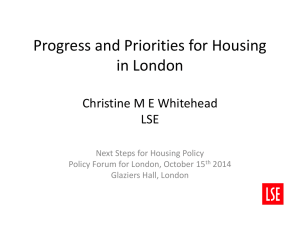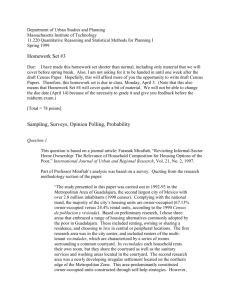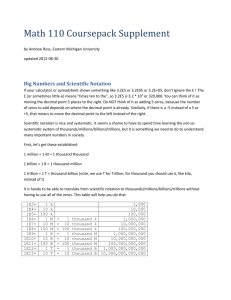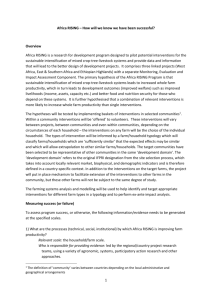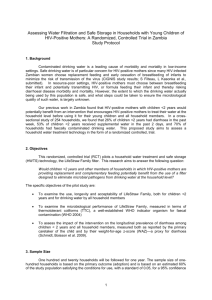File
advertisement
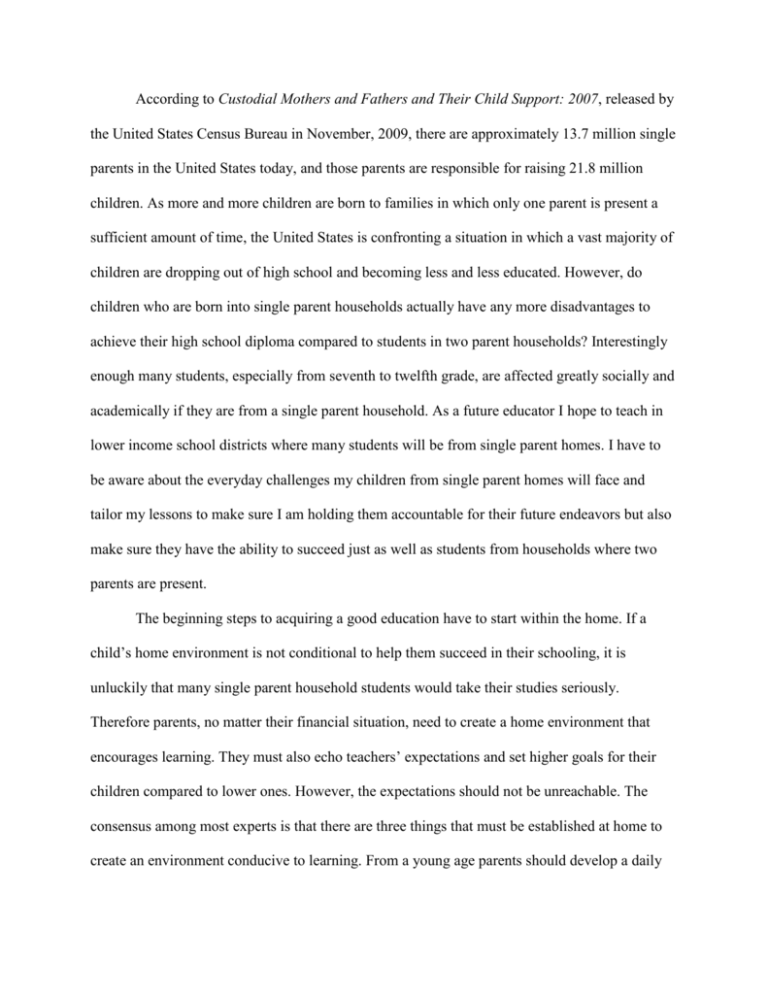
According to Custodial Mothers and Fathers and Their Child Support: 2007, released by the United States Census Bureau in November, 2009, there are approximately 13.7 million single parents in the United States today, and those parents are responsible for raising 21.8 million children. As more and more children are born to families in which only one parent is present a sufficient amount of time, the United States is confronting a situation in which a vast majority of children are dropping out of high school and becoming less and less educated. However, do children who are born into single parent households actually have any more disadvantages to achieve their high school diploma compared to students in two parent households? Interestingly enough many students, especially from seventh to twelfth grade, are affected greatly socially and academically if they are from a single parent household. As a future educator I hope to teach in lower income school districts where many students will be from single parent homes. I have to be aware about the everyday challenges my children from single parent homes will face and tailor my lessons to make sure I am holding them accountable for their future endeavors but also make sure they have the ability to succeed just as well as students from households where two parents are present. The beginning steps to acquiring a good education have to start within the home. If a child’s home environment is not conditional to help them succeed in their schooling, it is unluckily that many single parent household students would take their studies seriously. Therefore parents, no matter their financial situation, need to create a home environment that encourages learning. They must also echo teachers’ expectations and set higher goals for their children compared to lower ones. However, the expectations should not be unreachable. The consensus among most experts is that there are three things that must be established at home to create an environment conducive to learning. From a young age parents should develop a daily schedule that all their children should follow. This schedule should consist of daily chores, study times, and family obligations. Then if work is accomplished students should be given time for fun and relaxing activities. The idea is that then as children develop both socially and academically they have learned good habits both at home and at school that involve time management (Harderves 1998). By having these daily expectations students, no matter the home situation, have learned that there is a time for work and a time for play. If their homework and chores are not being accomplished than their free relaxation time will suffer for it. The last obligation all families have when dealing with students is allowing their home to be a place of study (Alika 2012). Parents need to make sure they are encouraging their children to study and have a good work ethic. In fact the “most accurate indicator of how well a student will achieve at the academic level is not income or social status, but the extent to which that student’s family is able to create a home environment that encourages learning” (Grace 2012). By having an environment where studying are incorporated into their daily lives, students will begin good academic skills at home and then be able to grow with them as they continue in school, therefore diminishing the gap that connects single parent students with poor academic performance. The daily expectations of children, however, should not be things that put great strain on their lives therefore making it impossible to concentrate on their studies. Most children who are in single parent households are faced with challenges that some children will never have to face if they come from a two parent household: How do I come by my basic necessities? Maslow’s Hierarchy of Needs states that if children’s basic needs are not being met then it is impossible for them to continue into the next categories of development. On average over sixty-seven percent of children over the age of thirteen in single parent household are working part time jobs to help aid their parents (McLanahan 1986). Children in these families are expected to make money to help pay for clothes, rent and in most instances food that is needed for the family members. Unfortunately, with only one parents having an income in these houses, children are expected to pitch in for fear of losing homes, incomes and essentially life for their parent cannot make ends meet on their own. Therefore, working for most students is more important their studies. As they age, students begin to fall behind in school and eventually drop out because paying bills is more important than getting an education, especially when many of them already have jobs. For single parent students it is not needed to expand their schooling because they believe the only reason to get an education is so they can get a job. After they have already acquired a job, schooling becomes a step they no longer are needed to take, therefore creating more and more uneducated people in poverty. The last predominate factor within single parent households is the number of teen pregnancies that continue among the children. In the United States teen pregnancy is on the rise and is seeing as more of a social norm because of the last of education in protection and the belief that increase in public funding for programs such as WIC and EBT cards is needed for children of poverty. The significance of non-married teen births in the United States lies in the numbers of teens affected and in the educational, health, economic, and social consequences for the teens and their children (Basch 2011). Now many of these teenage mothers and father are found to have come from households in which they were raised by a single parent (McLanahan 1986). As more and more students within single parent households lose hope of becoming anything more than what their parents have become, many students settle for their lives their parents live. Because of this, many students believe instead of becoming doctors, accountants or teachers, they instead will only amount to being single mothers living on welfare or baby daddy’s working at the local garage to help pay for child support. These of course are stereotypes that have been set by the social media but unfortunately many single parent children who believe them to be true. “Compared with women who delay childbearing until age 30, teen mothers’ education is estimated to be approximately 2 years shorter. Teen mothers are 10-12% less likely to complete high school and have 14-29% lower odds of attending college” (Basch 2011). The teens now have other more important responsibilities than furthering their education and because they did not finish school they teach those same lessons to their children who then teach it to their children. In the vicious circle more and more children feel education is more of an inconvenience compared to becoming teen parents and having unrealistic ideas of how life will be for them. With these families becoming more and more uneducated, it seems to be that as teachers, becoming proactive to incorporate the fact that children can overcome obstacles in life. It is also important to establish the fact that life will not be perfect but as students, all are given the opportunity to learn how to become a functioning member of society and should take advantage of the education that as a United States citizen they are entitled too. All articles present on this topic presented great ideas of the origin of the problem but gave great solutions that could be incorporate not only by teachers but also by the families affected by the single parent label. However, most of these researchers were not themselves from single parent households, therefore presenting the question: Can they really understand the daily struggles presented in the single parent household lifestyle? Nevertheless, because many students have achieved greatness even though coming from single parent households, it seems that as long as the students are being encouraged to continue their studies, then they can achieve academic proficiency. As stated previously in my introduction, my goal as a future educator is to take the skill I have acquired in my personal and educational experiences and teach within a low socio economic school district. Because of this, on a daily basis I will be confronted with students who come from single parent households. I needed to be aware that, in fact, my students in single parent households are truly at a disadvantage of academic achievement unless it is seen as important among their single parent. I will have to instill within my students the ideas that they can achieve anything no matter if they come from a single parent, two parent, white, black, adoptive household. We are not all dealt the same hand in life but we can either overcome these adversaries or become these adversaries. It may be a challenge to come from a single parent household to achieve greatness in the academic setting but it is not impossible and that is the key fact that I will have to repeat to my students to ensure they take their studies serious. Works Cited Alika, H., & Edosa, O. (2012). Relationship between broken homes and academic achievement of secondary school students. College Student Journal, 46(2), 256-263. Basch, C.E. (2011). Teen pregnancy and the achievement gap among urban minority youth. Journal of School Health, 81(10), 614-618. Grace, A., Jethro, O., & Aina, F. (2012). Roles of parent on the academic performance of pupils in elementary schools. International Journal of Academic Research in Business &Social Sciences, 2(1), 196-201. McLanahan, S. (1986). The consequences of single parenthood for subsequent generations. American Journal of Sociology, 90(1). 873-901



